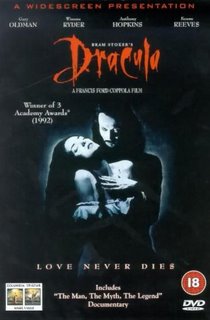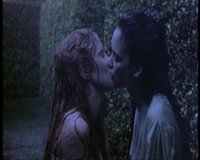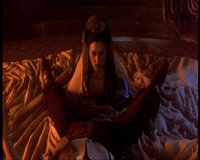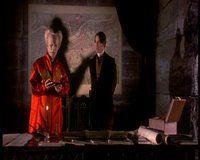
Director: Francis Ford Coppola
Release Date: 1992
Contains spoilers
Coppola’s vision of Dracula is very different to the '31 version, perhaps sharing a little more with the '79 version given that it focuses heavily on a romance. Yet many say that it is the closest to the Stoker story – not true. Whilst Coppola manages to draw a richly gothic romance he veers heavily from the original story.
The film starts in Transylvania, with Vlad Dracula (Gary Oldman) fighting the Turks. His wife Elisabeta (Winona Rider) is left in the castle as he goes to battle and the Turks, once defeated, fire an arrow (with a forged message) through a castle window causing her to commit suicide as she believes him dead. Now this is a mismatch of historical accuracy and inaccuracy, merged with the legends surrounding Vlad Tepes. He was a Walachian Prince, not Transylvanian, though the movement of location is consistent with Stoker. Reputedly Vlad’s first wife died in a way depicted in the film, though it was fear of the encroaching Turkish army that demanded Vlad’s surrender that was the catalyst. In the film, told by the church that she is damned as a suicide, Dracula curses himself; in life he married again. However, none of this is in the book, Dracula’s descent into undeath is hinted to be through the devil via his attendance at the Scholomance – the Devil’s academy.
All this sets the film up for the reason why this film is not an accurate remake of the book. Despite the fact that it has all the main characters from the book (unusually), the actual roles of the characters are changed. Mina (again, Winona Ryder) is the reincarnation of Elisabeta and the film tracks their love through time and darkness. She goes to Dracula willingly, betrays Harker (Keanu Reeves) and turns on Van Helsing (Anthony Hopkins) , calling him a murderer for killing Lucy, whereas she is grateful to Van Helsing - in the novel - for saving her friend's soul. She even helps the Count at the climax of the film, summoning storms to confound his pursuers. This is not Stoker’s Mina, who was a brave and intelligent woman who was picked by Dracula as an object of revenge against the mortals arrayed against him. The devolving of the story reaches a peak when it is Mina who kills the Count, not Harker, and it is her love setting them all free from darkness.
Coppola’s treatment of Lucy (Sadie Frost) fairs little better. She is depicted as a wanton hussy, not the sweet girl corrupted by the Count’s evil and demonstrates displays that would be simply unseemly within Victorian high society. Indeed Van Helsing actually states that she is a willing recruit to Dracula’s army of the undead, and their attempt to save her soul is despite her not for her. 
There is even a hint, not from the book, that there might be a more intimate relationship between Mina and Lucy beyond being best friends, going so far as to having the character’s kiss, though it is intimated that Dracula perhaps pushed this urge.
It must also be pointed out that Whitby is utterly lost from the film. Elements from the book are added and yet changed. Renfield (Tom Waits) is there, but he is a solicitor who lost his mind when attending Dracula before Harker – in the book he is a madman whose madness allows him to tune to Dracula’s wavelength and becomes almost a barometer of the vampire's comings and goings. It is one of the few films that shows the escape of the wolf from London Zoo, though in the book the wolf is used to attack Lucy and her mother whereas in this film it is used as a seduction technique as Dracula woos Mina. That said, Lucy attacked by a wolf is revisited as this is the form that Dracula takes when he makes his final attack upon her.
So does the film succeed anywhere? Frankly, yes. As I said at the head it is a richly photographed gothic romance and in this it works very well. Hopkins’ performance as Van Helsing is masterful, painting a much more manic Professor than in previous versions and yet obviously thoroughly enjoying himself. Oldman, as ever, throws himself into his character with consummate professionalism. 
Whilst the scene with the brides and their interaction with Harker strays from the book it is, perhaps, one of the most effective visions of the brides. Though the fact that Monica Bellucci is involved may have swung my opinion on that one.
The scene with Lucy in her crypt is far from accurate to the book. The heroes attendance is so easily gained that the hows and wherefores are missed totally and the blooferlady section is missed altogether. That said it is a gory and successful reworking, with Lucy going Linda Blair on Van Helsing, spewing blood at Van Helsing as he forces her into her coffin.
The heroes attendance is so easily gained that the hows and wherefores are missed totally and the blooferlady section is missed altogether. That said it is a gory and successful reworking, with Lucy going Linda Blair on Van Helsing, spewing blood at Van Helsing as he forces her into her coffin.
Special mention has to go to the fact that Coppola allowed Dracula access to the daylight hours. A part of the story too often missed in Dracula retellings.
One of my favourite parts of the film, however, was the way in which Coppola used Dracula’s shadow.  This was, in my opinion, a homage to Nosferatu. Coppola has the shadow moving independently of the Count which gives a kind of surrealistic feel to Harker’s imprisonment within the castle and allowed the director to show the direction of the Count’s true thoughts whilst he hid them behind his false civility. This device was so successful that it was wildly lampooned in Dracula - Dead and Loving it (1995).
This was, in my opinion, a homage to Nosferatu. Coppola has the shadow moving independently of the Count which gives a kind of surrealistic feel to Harker’s imprisonment within the castle and allowed the director to show the direction of the Count’s true thoughts whilst he hid them behind his false civility. This device was so successful that it was wildly lampooned in Dracula - Dead and Loving it (1995).
If I dwelled, at the head of the reviews, on the films inaccuracies it was because of the insistence by many that this was a faithful version of the book. It has many elements of the book that are too often missing, but misses swathes itself and rewrites the substance by making the Count a tragic romantic figure and introducing a passionate love between Mina and the Count. This, however, does not make it a bad film and it still deserves 8 out of 10.
The imdb page is here.
Bonus Mini Review
 Dracula (novelisation)
Dracula (novelisation)
Author: James V. Hart & Fred Saberhagen
The 1992 movie was, as we know, based on the Bram Stoker novel. Indeed it actually added Stoker’s name to the title. Why then, oh why, was the need found to novelise the movie? Yes, you heard right, there is a novel of the film of the novel.
I found this book in a charity shop and whilst it is a functional read it is entirely a pointless addition to the annals of vampire fiction. There is not a lot to be said in reviewing this, the book follows the film precisely – inaccuracies from the movie to the original masterpiece captured forever in words. It is only really worthwhile if you are a completist collector, 2 out of 10.
Monday, May 22, 2006
(Bram Stoker’s) Dracula {1992} - review
Subscribe to:
Post Comments (Atom)
















9 comments:
Yeah, I thought they went entirely too far with telling how Vlad supposedly became a vamp. This is something that i always find unnecessary in vamp movies. It's part of the fun of the genre that we don't know how it all started, and I don't find it important at all to learn.
But it being a gothic representation of the book is what I always liked about it. Indeed I had seen the movie before I'd ever read the book so I can not possibly read Dracula without imagining this gothic scenery.
I've always thought it strange that this film is called Bram Stoker’s Dracula when it takes so many liberties with the novel.
However, like you, I really enjoy this movie. It's one of the few films of the genre my wife likes as much (or even more than) me.
I'm glad you noted the likeness in plot to the '79 movie, as I think Coppola's version owes a lot to the earlier work.
You're good at this movie reviewing stuff!
Precisely why I put Bram Stoker in brackets!
I think all three of us are on the same page here, good film - not authentic to the book. Like you Mateo, I love the lush gothicness of the film.
Mark, my partner also like this one, I think it is the only vampire film she had on video when we met - though it is she who has all the Buffy tapes and not me.
Thanks for the kind words re the movie reviewing.
The richly romantic gothic visuals are glorious, so is the score, but you really nailed it - it is not BRAM STOKER´S Dracula.
I couldn't agree more... the romance element was more Dan Curtis than Bram Stoker
True. And why everybody wants to re-write Lucy as a "bad" girl!? I think Lucy in "Bram Stoker´s" Dracula was deliciously tarty eyeful, but the "unequalled sweetness and purity" of this ultra-feminine, "lily-like girl" rhapsodied by Stoker was quite self-describing.
Can't disagree - Lucy was an element that just did not work as it should in this - if this was going to be a true to the book film.
Her actions pre-turn were more akin to post-turn, as it were
This my girl's favorite film, and one of mine, too. I think while it strays a little from Stoker's book, it IS the closest one to it. Which other movie has all four male characters, plus the "pick a fiancee" scene? Which other film has the chase at the end, almost exactly like it happens in the book (with some changes at the end as you mentioned)?
Some details have changed, yes. But this is the only movie that pretty much covers all major scenes in the book. My only complaints are actually one of the things you liked: it's too gothic, too romantic, lacks the atmosphere of Herzog's Nosferatu or other vampire films. It's too big-budget in a way. Gary Oldman is good but not imposing enough, too short. And Keanu Reeves, of course, is one of all-time worst Harkers...
Cheers!
The T, to be honest it isn't the closest to Stoker's book. Whilst it isn't very good that honour has to rest with Alucard.
That said, and ignoring the Vlad Tepes bits, this is a great gothic romance... if we can cast Keanu Reeves and his amazing ever changing hair colour out of our minds... but, as you say, it hasn't perhaps the atmosphere of other films.
Cheers, as always, for stopping by and taking time to comment.
Post a Comment